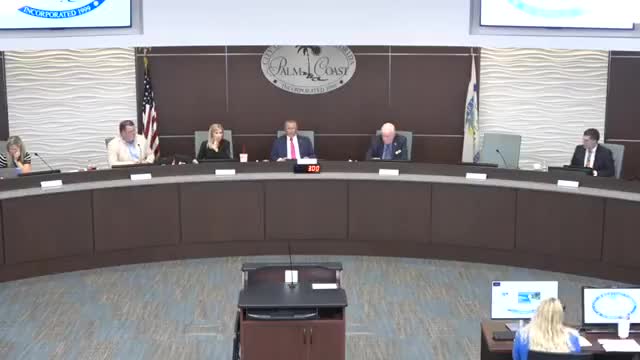Palm Coast council backs mail ballots and broader impacted-area approach for traffic-calming petitions; asks staff to cost signage and explore lowering local--
October 14, 2025 | Palm Coast City, Flagler County, Florida
This article was created by AI summarizing key points discussed. AI makes mistakes, so for full details and context, please refer to the video of the full meeting. Please report any errors so we can fix them. Report an error »

Palm Coast city staff presented a new traffic-calming application process on Oct. 14 and the City Council directed staff to use mailed ballots for resident engagement and adopt a defined “impacted-area” map when seeking homeowner approval for traffic-calming devices.
Transportation staff said the proposed process has three steps: resident application, an objective traffic study using defined speed and volume thresholds, and household engagement. The technical eligibility criteria presented to council require either: (a) the 80th-percentile speed to exceed the posted limit by more than 3 mph with an average daily traffic (ADT) over 2,000 vehicles, or (b) at least 10% of vehicles traveling 8 mph or more over the posted limit.
Staff presented three options for impacted-area boundaries (households on the affected route only; route plus households whose only access is the route; and a larger area that includes some streets with secondary access). After discussion council directed staff to adopt Option 2 (the route plus households that must use the route to enter/exit their neighborhood) as the default area for any traffic-calming petition.
For household engagement the council chose mail-in ballots as the preferred method (staff will mail ballots and track responses). Council specified the approval threshold at 70% of households in the impacted area; staff clarified that threshold applies to homeowners as described in the presentation. Councilmembers asked staff to ensure renters with stable residency can be included in ballots if desired, and requested that staff clarify homeowner-versus-renter eligibility in the process materials.
Several council members also asked staff to pursue broader options: multiple members expressed interest in exploring a citywide reduction of residential speed limits (for example lowering interior residential roads to 25 or 20 mph) rather than piecemeal device-by-device traffic calming. The council directed the city manager to obtain updated costs and procurement options for replacing or adding speed-limit signage (staff noted the previous estimate to change all residential signs was large and not budgeted). Staff said the traffic-calming program is scheduled to open January 2026 and that eligible roads will be included in the FY27 budget proposal for implementation funding.
Staff will prepare the impacted-area map, a mail-ballot process, and an outreach plan; council asked staff to return with statutory guidance on speed-limit posting and the procurement cost for signage so members can consider whether a citywide change is feasible in next year’s budget.
Transportation staff said the proposed process has three steps: resident application, an objective traffic study using defined speed and volume thresholds, and household engagement. The technical eligibility criteria presented to council require either: (a) the 80th-percentile speed to exceed the posted limit by more than 3 mph with an average daily traffic (ADT) over 2,000 vehicles, or (b) at least 10% of vehicles traveling 8 mph or more over the posted limit.
Staff presented three options for impacted-area boundaries (households on the affected route only; route plus households whose only access is the route; and a larger area that includes some streets with secondary access). After discussion council directed staff to adopt Option 2 (the route plus households that must use the route to enter/exit their neighborhood) as the default area for any traffic-calming petition.
For household engagement the council chose mail-in ballots as the preferred method (staff will mail ballots and track responses). Council specified the approval threshold at 70% of households in the impacted area; staff clarified that threshold applies to homeowners as described in the presentation. Councilmembers asked staff to ensure renters with stable residency can be included in ballots if desired, and requested that staff clarify homeowner-versus-renter eligibility in the process materials.
Several council members also asked staff to pursue broader options: multiple members expressed interest in exploring a citywide reduction of residential speed limits (for example lowering interior residential roads to 25 or 20 mph) rather than piecemeal device-by-device traffic calming. The council directed the city manager to obtain updated costs and procurement options for replacing or adding speed-limit signage (staff noted the previous estimate to change all residential signs was large and not budgeted). Staff said the traffic-calming program is scheduled to open January 2026 and that eligible roads will be included in the FY27 budget proposal for implementation funding.
Staff will prepare the impacted-area map, a mail-ballot process, and an outreach plan; council asked staff to return with statutory guidance on speed-limit posting and the procurement cost for signage so members can consider whether a citywide change is feasible in next year’s budget.
View full meeting
This article is based on a recent meeting—watch the full video and explore the complete transcript for deeper insights into the discussion.
View full meeting